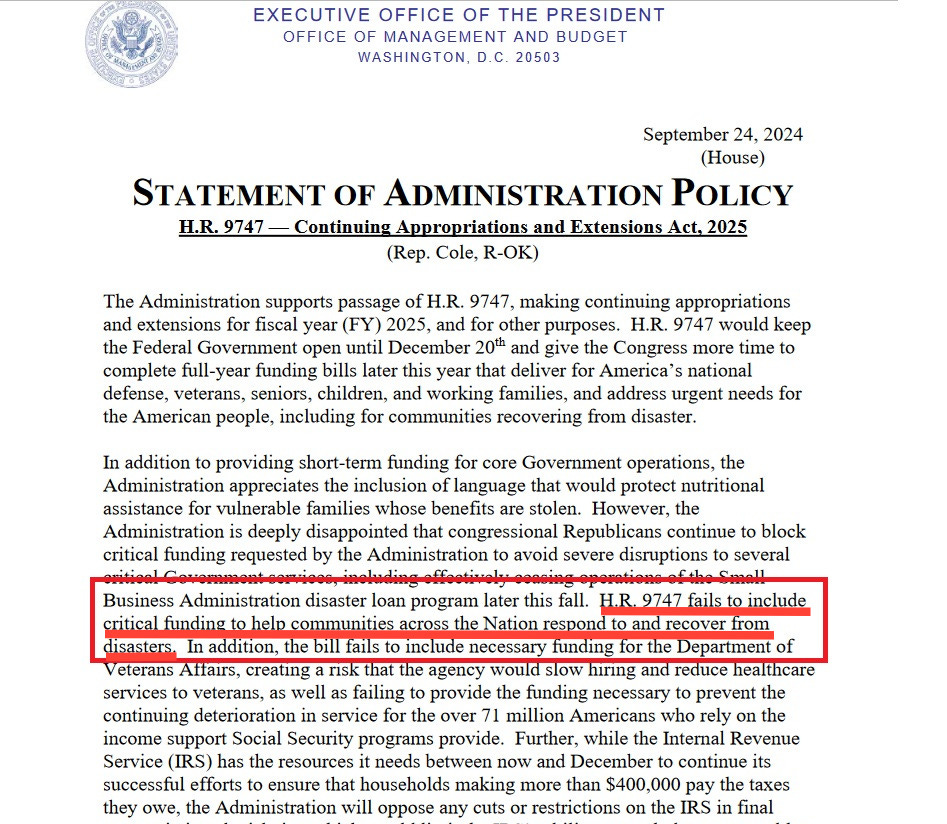Tell me if you’ve seen this one before.
A friend shares a meme on social media of a crying little girl clutching a terrified, soaked puppy, big brown eyes staring into the distance, surrounded by water, tears and rainwater streaming down her tiny face.
Senator Mike Lee shared this AI image on his personal X account, encouraging his followers to caption the “photo,” in an effort to somehow blame Kamala Harris for the administration’s response to Hurricane Helene that ostensibly abandoned puppies and children. Lee apparently deleted this post after someone with half a brain informed him that it was an AI-generated image (apparently in Mike Lee’s world people’s eyebrows actually do this and blurry people with missing arms ride in rescue boats).
I’ve seen others share this and other ridiculous memes on social media in an effort to promote their side of the political story.
When informed that the photo is fake, they proceed to defend their share of the picture by claiming that it’s the sentiment that counts—the sentiment being that the Biden administration has failed the people.
Amy Kremer, RNC National Committeewoman for the Georgia GOP and co-founder of Women for Trump, who shared the photo, doubled down after being informed that it’s an AI-generated fake. Others also refused to back down from using the fake image to generate support for their “side.”
“Y’all, I don’t know where this photo came from and honestly, it doesn’t matter,” [Kremer] replied. “There are people going through much worse than what is shown in this pic. So I’m leaving it because it is emblematic of the trauma and pain people are living through right now.” A large anonymous blue-check account on X that routinely attacks Democrats did remove the picture but similarly argued: “Even though that image was AI, it spoke a truth about the disregard Harris and Biden have for ordinary Americans, as evidenced by their criminal non-response to Helene.” Another X user posted a screenshot of a more succinct response from an apparent family member advised that the image was bogus. “Who cares,” they answered.
A person whom I consider a friend, and who should really know better, recently shared this idiotic meme on social media.
“The general idea that Democrats care more about getting money to foreign countries than using it to take care of people here is a valid concern,” he claimed when I called out the meme as ridiculous, considering that the majority of aid we send to Ukraine is weapons and ammunition, produced in the United States by Americans in more than 70 cities, creating American jobs and supporting U.S. companies, according to the American Enterprise Institute.
In other words, according to his response, who cares if the meme is disinformation? It’s the sentiment that counts.
North Carolina and other areas impacted by Hurricane Helene don’t need ammunition and weapons systems, and disaster areas were declared there within days. According to a late September White House Fact Sheet, more than 3,500 personnel from across the federal workforce were deployed and supporting Hurricane Helene response efforts across the impacted states. In addition, 1,250 Urban Search and Rescue personnel were deployed across Florida, North Carolina, South Carolina and Tennessee. Together with local and state responders, teams have rescued or supported more than 1,900 people, including nearly 900 in North Carolina.
President Biden approved “Major Disaster” declaration for North Carolina on September 27, South Carolina and other states, allowing survivors to immediately access funds and resources to jumpstart their recovery.
Some were screaming about the one-time $750 payment to those impacted by Helene, comparing it to the billions of dollars received by Ukraine without researching further to find out that the payment was just part of a much larger effort to help with essential items like food, water, baby formula, and other emergency supplies.
And no, the money for disaster relief has not been diverted for illegal immigrants. FEMA has dedicated disaster relief funds that cannot be used for anything other than disaster relief. Homeland Security Secretary Alejandro Mayorkas did say that FEMA would need more money for the rest of the hurricane season and Helene recovery, but that doesn’t mean that the disaster relief—or Majors—fund was raided to pay for illegal immigrants.
Fact is, it’s up to Congress to appropriate additional money for disaster relief. The White House on September 24 actually called on Congress to add funding for disaster relief to the Continuing Resolution that keeps government operating through December 20. That was a no-go.
The decision to return early is up to Speaker Mike Johnson and Senate Majority Leader Chick Schumer, and Johnson has already confirmed that he has no plans to reconvene Congress until after the November elections.
Nonetheless, people continue to shriek about the Biden administration caring more about Ukraine than they do about domestic victims of Hurricane Helene.
The disinformation currently shared about the current administration’s Helene response smacks heavily of Russia’s and China’s disinformation efforts after wildfires hit Maui last year. The message was that aid to Hawaii was inadequate because too much money was going to Ukraine.
Last year, after the government announced an additional $200 million in aid to Ukraine, the victims in Hawaii were offered $700. This was by far not all the aid that Hawaii received, but nonetheless, Russia’s trolls and bot accounts went to work, claiming that the administration’s priorities put foreign aid over victims at home.
Russia jumped into the game a day or two after the fires started.
It spread the phrase, “Hawaii, not Ukraine,” from one obscure account with few followers through a series of conservative or right-wing accounts like Breitbart and ultimately Russian state media, reaching thousands of users with a message intended to undercut U.S. military assistance to Ukraine.
Meanwhile, China’s disinformation campaign focused on conspiracy theories about how the wildfires in Maui were started.
The disaster was not natural, they said in a flurry of false posts that spread across the internet, but was the result of a secret “weather weapon” being tested by the United States. To bolster the plausibility, the posts carried photographs that appeared to have been generated by artificial intelligence programs, making them among the first to use these new tools to bolster the aura of authenticity of a disinformation campaign.
Sound familiar?
Emotions are a major driver of behavior. The heartbreak evoked by the picture of the little girl and her puppy is an effective tool to compel the viewer to share disinformation. The more individuals and accounts share the photo, implying that money going to Ukraine could be helping innocent victims of the hurricane, the more likely Russian media is to pick up the story, which will then be shared by major media outlets.
Emotional appeals circumvent critical thinking, according to the US Army, and that’s what makes them more effective.
War is shaped by human nature and the complex interrelationship of cognitive (how people think) and psychological (mental or emotional state of a person) factors. Values and ethics are some of the factors that motivate both the cause for going to war as well as restrictions on the conduct of war. Fear, passion, camaraderie, grief, and many other emotions affect war participants’ resolve. Emotions affect the behavior of combatants, how and when leaders decide to persevere, and when to give up. Individuals react differently to the stress of war; an act that may break the will of one enemy may only serve to stiffen the resolve of another. The will to act and fight emerges from the complex interrelationships in this dimension. Influencing these factors—by affecting perceptions, attitudes, and motivations—should underpin most, if not all, military objectives.
This is true not just of conventional warfare, but also information operations. Russia understands this principle better than most countries, according to the US Army War College. While every country controls narratives to some extent, few emphasize information operations on par with Russia. The Kremlin’s hybrid warfare includes disinformation and has for decades.
Journalist Mark Hollingsworth devotes a chapter to the KGB’s use of disinformation in his book Agents of Influence: How the KGB Subverted Western Democracies. He cites a former KGB disinformation chief who claimed the KGB spent around 25 percent of its budget on traditional espionage, spending the remainder on “a slow process focusing on what we called ideological subversion or active measures.
What better way to make active measures the most effective?
Pull on the heartstrings.
Appeal to values and ethics.
Appeal to sympathy for innocent victims.
Exploit Americans’ natural tendency to distrust the government, and exacerbate those sentiments.
Russia uses disinformation to damage trust in the US government abroad and exploit the American fascination with conspiracy theories, damaging trust regarding the September 11 attacks on the World Trade Center and Pentagon, the COVID-19 pandemic, election security, and other events.
This is why the appeals to sentimentality are so effective. By triggering emotions such as distrust, sadness, anger, and fear, Russia and other state actors can spread their disinformation more effectively, knowing that those advancing those narratives will do so likely without critical thinking, without fact checks, and with maximum emotional response. Research shows that Russia’s Internet Research Agency, owned by the formerly alive sanctioned warlord Evgeniy Prigozhin, “used increasingly aggressive language on social media during and immediately preceding the 2016 election.” Aggressive language evoked feelings of anger and frustration.
Additional research also revealed the increased use of aggressively negative hashtags such as #zelenskylies and #fuckbiden on social media after Russia began its full-scale invasion of Ukraine.
In a joint investigation with German media outlet Der Spiegel, Riga-based The Insider exposed a Russian SVR operation codenamed “Project Kylo,” whose objective was to stoke anti-government sentiments in the West, particularly over liberal democracies’ support for Ukraine. And the key emotions to prey upon, the SVR planners intoned, were “fear,” “panic” and “horror,” echoing active measures from the Soviet KGB’s First Chief Directorate’s Department D. The D stood for disinformation.
There’s good reason why the EU is moving to create a new framework to sanction Russia’s hybrid capabilities, and the Parliamentary Assembly of the Council of Europe has adopted a resolution calling for sanctions against Russian propagandists.
There’s good reason why the United States has been targeting Russian propaganda mill RT and its efforts to coopt western influencers and spread disinformation.
Western powers are beginning to understand just how harmful Russia’s propaganda efforts are, even supposedly “minor ones” like sharing memes echoing Russian messaging.
You should too. The more disinformation you share, the more individuals in your sphere reshare it, the more people will continue spreading the propaganda virus. Once sufficient numbers of individuals share the disinformation, it will almost certainly be “reported” by Russian campaigns such as “Doppelgänger,” which created numerous “news” domains that mimicked legitimate media outlets, including the Washington Post, Fox News, Reuters, German Der Spiegel and Bild, French Le Monde, and others, and which helped spread the disinformation. Russian media also will pick up the “story,” citing major “media sources,” many mimicked by operations such as Doppelgänger.
And so on, and so on, and so on.
So no. The response to an obviously fake contention in a meme shouldn’t be “Well, the sentiment is still valid.” Sentiments should be based on solid research, not on crude and obvious efforts to manipulate emotions. There’s nothing innocuous about sharing these memes, because at least one person you know will take them as gospel, raise a partisan discussion about the content without doing a shred of research or critical thinking, or claim that they have friends in the impacted disaster area who confirm the assertion in the meme (much similar to claiming that you have a girlfriend who lives in Niagara Falls).
Do your research, and stop falling victim to emotional manipulation.













Ryan McBeth says to beware the memes that are designed to raise outrage, and here again he is correct.
But OldNFO is also correct: there are horrific stories coming out of NC, and many of them point to a general incompetence of FEMA. It appears that organizations like the Southern Baptist Convention, Samaritan’s Purse, the Cajun Navy, and others are making a positive impact for the victims.
Key point- "Emotions are a major driver of behavior" and EVERY side will use anything they can to spin the narrative in the direction they want it to go. But I will say there are plenty of horror stories coming out of North Carolina that are real, and proven that a lot of folks are 'ignoring'... sigh